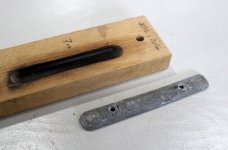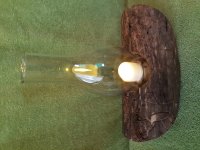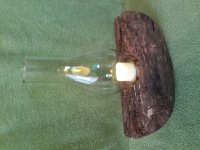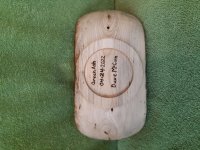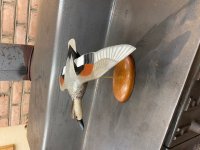You are using an out of date browser. It may not display this or other websites correctly.
You should upgrade or use an alternative browser.
You should upgrade or use an alternative browser.
What's on your WORK BENCH ? - APRIL 2022
- Thread starter Steve Sanford
- Start date
Matt Mahoney
Active member
Steve,
My holly keels are only about 3/16" and epoxied into a dado in the decoy. Hand placement is an option, but as my rig grows, tossing them from the boat would be nice. I suppose that I could just bolt a lead strip to the side of the keels. they protrude about 3/4-1".
Matt
My holly keels are only about 3/16" and epoxied into a dado in the decoy. Hand placement is an option, but as my rig grows, tossing them from the boat would be nice. I suppose that I could just bolt a lead strip to the side of the keels. they protrude about 3/4-1".
Matt
Steve Sanford
Well-known member
Matt~
A very experienced carver once told me his secret to self-righting: place the ballast slightly off center.
Of course, the boat builder in me recoiled - offset centerboard trunks in Sneakboxes notwithstanding - to anything that was not perfectly symmetrical. In your case, you might want to put some lead on both sides of the keel....
All the best,
SJS
A very experienced carver once told me his secret to self-righting: place the ballast slightly off center.
Of course, the boat builder in me recoiled - offset centerboard trunks in Sneakboxes notwithstanding - to anything that was not perfectly symmetrical. In your case, you might want to put some lead on both sides of the keel....
All the best,
SJS
Matt Mahoney
Active member
Will give it a try Steve. Thanks,
Matt
Matt
Steve Sanford said:Matt~
A very experienced carver once told me his secret to self-righting: place the ballast slightly off center.
Of course, the boat builder in me recoiled - offset centerboard trunks in Sneakboxes notwithstanding - to anything that was not perfectly symmetrical. In your case, you might want to put some lead on both sides of the keel....
All the best,
SJS
It has a bit to do with the height of the heads. Low heads tend to require a bit more ballast in or on the keels. Sometimes, offsetting and angling the keels will also produce the desires swimming motion. You might also play with where you drill holes for the lines Slightly ahead of center will often give feeders the illusion of turning in circles to feed. I generally woek with a one inch wide by one and a half inch deep keel for most puddlers nd divers. The larger the bird, the more lead cylinders -34/" forstner bit to drill the holes- Puddlers forward of center, divers, aft. This might be helpful.
Matt Mahoney
Active member
Thank you George.
Matt
Matt
george w said:It has a bit to do with the height of the heads. Low heads tend to require a bit more ballast in or on the keels. Sometimes, offsetting and angling the keels will also produce the desires swimming motion. You might also play with where you drill holes for the lines Slightly ahead of center will often give feeders the illusion of turning in circles to feed. I generally woek with a one inch wide by one and a half inch deep keel for most puddlers nd divers. The larger the bird, the more lead cylinders -34/" forstner bit to drill the holes- Puddlers forward of center, divers, aft. This might be helpful.
Steve Sanford
Well-known member
Good morning, Eric~
That has happened to me more than once - and my compressor is not big enough for me to put it back together myself. It does remind me of one day several years ago, though, where everything that did go wrong could go wrong. Sometimes all you can do is put one foot in front of the other and hope you're going forward .... Nevertheless, I have a guy in town with a "blaster" that will pop the most stubborn tire back onto the rim.
All the best,
SJS
That has happened to me more than once - and my compressor is not big enough for me to put it back together myself. It does remind me of one day several years ago, though, where everything that did go wrong could go wrong. Sometimes all you can do is put one foot in front of the other and hope you're going forward .... Nevertheless, I have a guy in town with a "blaster" that will pop the most stubborn tire back onto the rim.
All the best,
SJS
Steve Sanford
Well-known member
Good morning, Matt~
As George mentioned, high-heads are easier to ballast for self-righting. Tucks and Sleepers can be a challenge - but I always strive for modest keels - and avoid the ocean-going sailboat approach.
Here's the keel for my Broadie-beak. Sorry for the poor exposure. The keel has about 9 ounces of lead and weighs 11 ounces total. The bird itself is only 18 ounces without the keel.

I bore the slot in the keel with a Forstner on the drill press - and go about 3/4-inch deep. I clean it up with a knife and drill "ears" at each end to prevent the lead from ever falling out. I bore a 3/8-inch hole for the anchor line.

The bottom and keel have been sealed with Spar Varnish then top-coated with a semi-gloss latex.
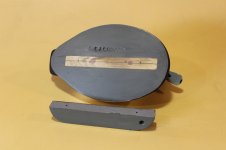
The keel is fastened with 2 brass screws. I put it on dry for sea trials - but will bed it in a paintable silicone caulk once I know it's OK.
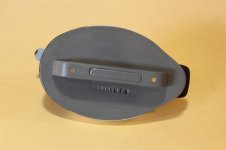
First toss! (He'll be thrown 3 times just to be sure.)
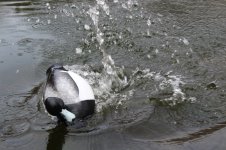
He popped upright instantly each time.

And, he floats "on his marks" like a proper little vessel.
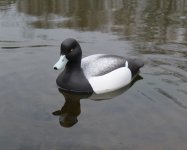
Broadside....
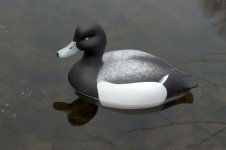
Back on terra firma - ready to be fitted with a proper line (72 lb braided nylon) and anchor.
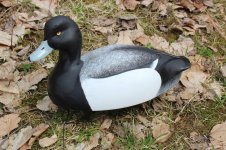
All the best,
SJS
As George mentioned, high-heads are easier to ballast for self-righting. Tucks and Sleepers can be a challenge - but I always strive for modest keels - and avoid the ocean-going sailboat approach.
Here's the keel for my Broadie-beak. Sorry for the poor exposure. The keel has about 9 ounces of lead and weighs 11 ounces total. The bird itself is only 18 ounces without the keel.

I bore the slot in the keel with a Forstner on the drill press - and go about 3/4-inch deep. I clean it up with a knife and drill "ears" at each end to prevent the lead from ever falling out. I bore a 3/8-inch hole for the anchor line.

The bottom and keel have been sealed with Spar Varnish then top-coated with a semi-gloss latex.

The keel is fastened with 2 brass screws. I put it on dry for sea trials - but will bed it in a paintable silicone caulk once I know it's OK.

First toss! (He'll be thrown 3 times just to be sure.)

He popped upright instantly each time.

And, he floats "on his marks" like a proper little vessel.

Broadside....

Back on terra firma - ready to be fitted with a proper line (72 lb braided nylon) and anchor.

All the best,
SJS
Eric Patterson said:Just going to be one of those weekends at the hunting property....
Those trees must have known you were coming after them. When the tank mount failure wasn't enough, they recruited that tire as an ally against you.
Matt Mahoney
Active member
Steve,
Wow! 1/2 lb of lead! Thanks for the tutorial. I will embark on taped-on sinker experiments.
Matt
Wow! 1/2 lb of lead! Thanks for the tutorial. I will embark on taped-on sinker experiments.
Matt
Huntindave McCann said:Those trees must have known you were coming after them. When the tank mount failure wasn't enough, they recruited that tire as an ally against you.
Dave it sure seemed like it. I actually think we are winning the war against the Callery Pears, but they are putting up one heck of a fight. I'll have a new tire tomorrow and in a few weeks will be back spraying the pear death cocktail.
Eric

